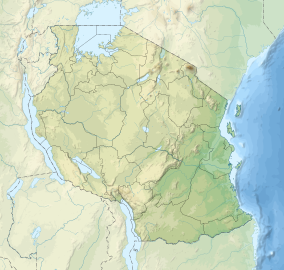| Kitulo National Park | |
|---|---|
 | |
| Location | Tanzania |
| Nearest city | Mbeya |
| Coordinates | 9°05′S 33°55′ECoordinates: 9°05′S 33°55′E |
| Area | 413 km2 |
| Established | 2005 |
| Visitors | 409 (in 2012[1]) |
| Governing body | Tanzania National Parks Authority |
(TANAPA))
Kitulo National Park is a protected area of montane grassland and montane forest on the Kitulo Plateau in the southern highlands of Tanzania. The park is at an elevation of 2,600 metres (8,500 ft) between the peaks of the Kipengere and Poroto mountains and covers an area of 412.9 square kilometres (159.4 sq mi),[2] lying in Mbeya Region and Njombe Region. The park is administered by Tanzania National Parks (TANAPA) and is the first national park in tropical Africa to be established primarily to protect its flora.[3]
Locals refer to the Kitulo Plateau as "Bustani ya Mungu" ("The Garden of God"), while botanists have referred to it as the "Serengeti of Flowers".[2]
Creation of the park[edit]
Protection of the Kitulo Plateau's unique flora was first proposed by the Wildlife Conservation Society (WCS), in response to the growing international trade in orchid tubers and increased hunting and logging activities in the surrounding forests.[4] In 2002, President Benjamin Mkapa announced the establishment of the park. The park was formally gazetted in 2005,[5] becoming Tanzania's fourteenth national park. TANAPA has stated that the park could be expanded in the future to include the neighbouring Mount Rungwe forest.[6]
Kitulo Plateau[edit]
The Kitulo Plateau lies between two parallel ridges. Its montane grasslands are home to 350 species of plants, including numerous ground orchids, geophytes, and other Afroalpine plants. During the November to April wet season the montane grasslands are carpeted with displays of flowers. Many species are limited to the Kipengere Range and nearby highlands, and three – Brachystelma kituloensis, Impatiens rosulata and Pterygodium ukingense – are limited the Kitulo Plateau.[7]
Livingstone Forest[edit]
The Livingstone forest is a montane evergreen forest that descends the souttwestward-facing slope of the park. It is the largest block of forest in the park, and the largest in the Kipengere Range. Thickets of bamboo (Yushania alpina) can be found between the upper montane forests and the high altitude grasslands. The Livingstone Forest lies in the former Livingstone Forest Reserve (240.34 km²), which was incorporated into the national park when it was created in 2005.[8] The Bujingijila Gap, a narrow corridor of farms and tree plantations, separates the Livingstone Forest from the Mount Rungwe forests.
The Livingstone Forest is home to three limited-range species of mammals – the endangered Kipunji (Rungwecebus kipunji), Rungwe dwarf galago (Galagoides sp. nov.),[9] and Abbott's duiker (Cephalophus spadix).[10] All three species also live in the forests of nearby Mount Rungwe.
In 2005, field scientists from the WCS discovered a new species of primate on and around Mount Rungwe and in the Livingstone Forest area of the park.[11] Initially known as the Highland Mangabey, later changed to its Tanzanian name of Kipunji, it is one of the 25 most endangered primates in the world.[12]
Ndumbi Forest[edit]
The Ndumbi forest, at the eastern end of Kitulo National Park, includes montane evergreen forest and forests of East African Cedar (Juniperus procera).[13] The former Ndumbi Valley Forest Reserve (27.71 km²) was established in 1956, and was incorporated into the national park when it was created in 2005.[14] The Ndumbi forest is also home to a 100-meter waterfall.
References[edit]
- ^ "Tanzania National parks Corporate Information". Tanzania Parks. TANAPA. Archived from the original on 20 December 2015. Retrieved 22 December 2015.
- ^ a b Kitulo National Park, Official Website, Tanzania National Parks, accessed 20 November 2014 Archived 20 September 2012 at the Wayback Machine
- ^ "Tanzania's New National Park Protects Edible Orchids". Environment News Service. 21 March 2002.
- ^ "Tasty orchids are selling like hotcakes in Tanzania". Mail and Guardian Online. 6 March 2003.
- ^ "Strengthening the Protected Area Network in Southern Tanzania: Improving the Effectiveness of National Parks in Addressing Threats to Biodiversity" (PDF). Global Environment Facility. 24 December 2010. p. 21. Archived from the original(PDF) on 28 September 2013.
- ^ Corporate Information, Official Website, Tanzania National Parks, accessed 20 November 2014 Archived 20 December 2015 at the Wayback Machine
- ^ Jon C. Lovett and Erik Prins (1994) "Estimation of land-use changes on Kitulo Plateau, Tanzania, using satellite imagery". Oryx Vol 28 No 3 July 1994.
- ^ "Livingstone Forest Reserve". Protected Planet. Accessed 5 September 2019. [1]
- ^ Charles Foley, Lara Foley, Alex Lobora, Daniela De Luca, Maurus Msuha, Tim R.B. Davenport, Sarah M. Durant (2014). "A Field Guide to the Larger Mammals of Tanzania". Princeton University Press, 2014.
- ^ "Cephalophus spadix (Abbott's Duiker)". IUCN Red List. Accessed 7 September 2019. [2]
- ^ "New Primate Discovered In Mountain Forests Of Tanzania". sciencedaily.com. 29 May 2005.
- ^ "25 Most Endangered Primates: The Kipunji". Primate Specialist Group. Archived from the original on 2011-07-27. Retrieved 2011-03-11.
- ^ "Strengthening the Protected Area Network in Southern Tanzania: Improving the Effectiveness of National Parks in Addressing Threats to Biodiversity." Project Document for UN Environment Program, Republic of Tanzania, and Global Environment Facility. Accessed 5 September 2019.
- ^ "Ndumbi Forest Reserve" Protected Planet. Accessed 5 September 2019. [3]
External links[edit]
| Wikimedia Commons has media related to Kitulo National Park. |
- IUCN Category II
- Geography of Njombe Region
- Geography of Mbeya Region
- National parks of Tanzania
- Protected areas established in 2005
- Southern Highlands, Tanzania
- Southern Rift montane forest-grassland mosaic
- Tourist attractions in the Njombe Region
- Tourist attractions in the Mbeya Region
- 2005 establishments in Tanzania



Comments
Post a Comment